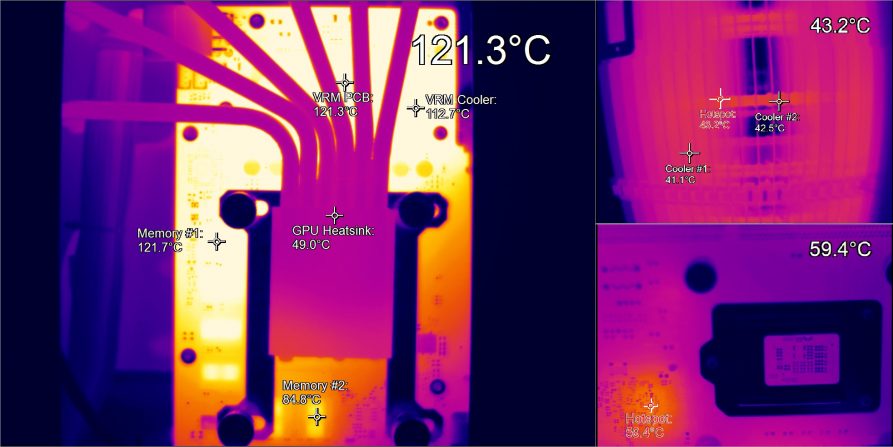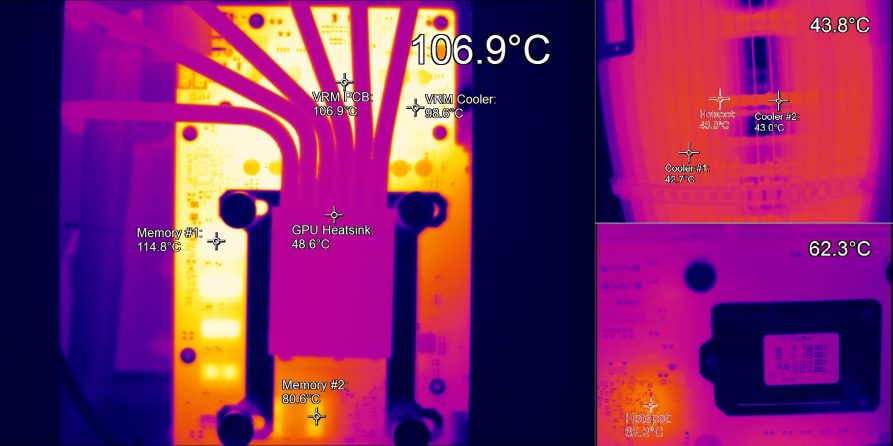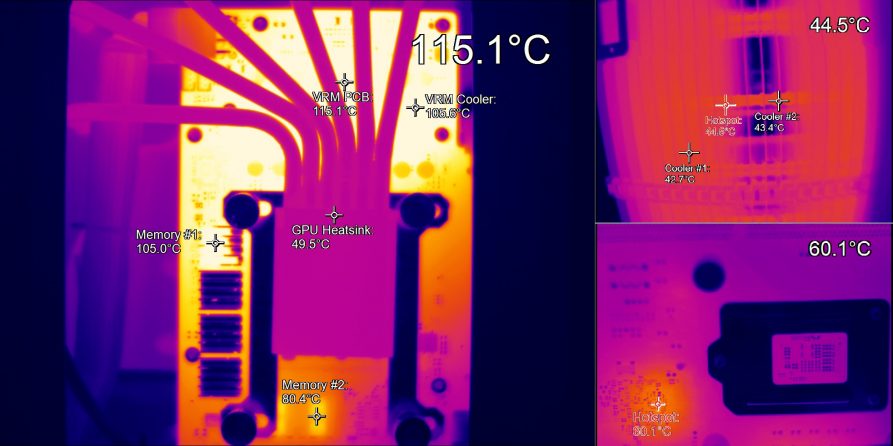Purely sensory: Case vs. graphics card 1:0
One thing I have to say is that the thermal limits of The Monsterlabo First are NOT due to the GPU or the brutal heatsink, but are based on the construction of the graphics card. With approx. 25 watts of power dissipation on the four phases, this area quickly becomes a fireflies. In addition, there are the approx. 2 watts per RAM module, whereby the voltage converters, the coils and also the conductor tracks provide an almost brutal warm-up due to the high flowing currents.
For the gaming test I use As always Witcher 3, but this time in Full HD, but again with maximum details. In total, the OC card even draws approx. 175 watts as a total work of art, then approx. 1830 MHz, whereby one can calculate that here approx. 115 watts via the CPU to the heatsink. for the CPU, this time they do not have 45 watts, which they can count on approx. 42 °C package temperature also passes almost freezing to the heatsink.
In total, therefore, approx. 160 watts to the heatsink, while the sum of what is additionally released into the ascending air by the boards of the motherboard and the graphics card should not exceed the 40 watt limit. 200 watts for a passive housing is a lot, but we see that this construction gets away with it easily! At least if you look at the sensor values. But right now the technology comes into play, which mercilessly reveals what you can't log with any software in the world.
Vulnerability Graphics Card PCB
What did the protagonists of the totals beat me up when I compared the TDP and the TGP of graphics cards! What counts would be at the socket and nothing else… But why I always ride on such (supposed) little things is shown in the following picture, which I took after the complete Witcher heating. As I said, the GPU is bubbling here at approx. 60 °C, while the VRM and at least three memory modules re-enact the hot film Beyond Africa. For those who haven't seen it, taming wild characters ends in a fiasco.
Above 121 °C is a thermal declaration of bankruptcy, only that the housing can do nothing for it. But it also clearly shows that the passive cooling of a graphics card cannot and must not be limited to the GPU, but that one has to look at all of this in a holistic way. Which brings us back to my pea counting with the difference between TDP and TGP, that is, what the GPU itself is doing and what is being fed to the board overall. Only that this nasty rest has to go somewhere.
Now you reduce the power target to approx. 70% and clocks down the memory by 400 MHz, then the VRM temperatures drop by an astonishing 15 °C, but in the end this is still too much to breathe a long life into a board. Here this becomes more of an outing of the same (outgassing, bending). However, the store, with its uncooled 115 °C, is still on death row and is awaiting its thermal execution by the grill. No, that is not the way to go.
Now let's check the whole thing for over an hour (!) with four glued-on RAM coolers and swoops you are down to 105 °C as the final value. By the way, these still result from the terribly hot board and the memory would run without this heat whip from the direction of VRM guaranteed to run within the specs. Who has learned, after all, that one should absolutely cool the memory, at least the relevant modules. Unfortunately, the mounting bracket covers one of the modules, so that this becomes impossible with the heat sink. However, it is not necessarily necessary at the point in question. Lucky again.
Conclusion and summary for Part 1
At this point, I deliberately cancel the experiment, because I turn in circles with this graphics card. The problem here is not the housing, but what you ended up with. Since the Monsterlabo First is offered as an empty housing, the task of fitting and thus the responsibility falls exclusively on the buyer, which is ok at first. However, he should also know the problem of graphic card designs and that's where I see black.
I will sit down with Monsterlabo until part 2 and play through possible solutions. I could well imagine with combined GPU VRM heatsinks for selected graphics cards similar to the GPU water blocks. This could also buy the pixel slingshots a little bit the cutting edge, which would otherwise like to destroy themselves. The crux of the matter here lies in the non-cooled surfaces and not with the radiator design of the housing.
For this very reason, I see the whole project up to this point with a laughing and a crying eye. And I see it as a challenge to anyone who bravely takes on this thermal balance act. But seriously, what would life be without real tasks? Boring!
From my own experience, I see the VGA assembly more in the context of a GeForce GTX 1660 (Ti), if you stick the appropriate RAM coolers on. This will be thermally solvable and will also be able to remain below the 100°C mark. But an attempt or I still have a housing. And then I put that in with what is really suitable for passive solutions. It should definitely be worth it, the pure cooling capacity is the Monsterlabo First the very first cream. Now all that remains is to vote for the rest! So you read again, guaranteed!


































Kommentieren